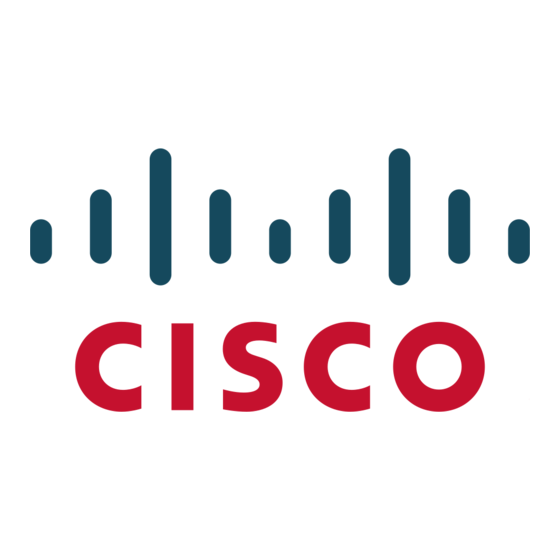Cisco WS-X6548V-GE-TX= Gegevensblad - Pagina 5
Blader online of download pdf Gegevensblad voor {categorie_naam} Cisco WS-X6548V-GE-TX=. Cisco WS-X6548V-GE-TX= 18 pagina's. Cisco catalyst x6524: supplementary guide
Ook voor Cisco WS-X6548V-GE-TX=: Kennisgeving (4 pagina's), Witboek (18 pagina's)

All contents are Copyright © 1992–2007 Cisco Systems, Inc. All rights reserved. This document is Cisco Public Information.
The Cisco Catalyst 6500 Series offers advanced network-management features to make it easy
to manage fast-growing networks. This includes TDR supported on the new 48-port 10- and 100-
Mbps and all the 48-port 10-, 100-, and 1000-Mbps Ethernet modules (part numbers WS-X6148A-
RJ-45, WS-X6148A-45AF, WS-X6148A-GE-TX, WS-X6148A-GE-45AF, WS-X6148-GE-TX,
WS-X6548-GE-TX, and WS-X6748-GE-TX, respectively). TDR tests cabling by sending a
signal down the cable, reporting cable breaks, cable crimps, and improperly wired cable.
All Ethernet modules support extensive interface-level statistics, including four RMON groups:
alarms, events, history, and statistics. Additional RMON groups (all nine groups) can be monitored
using the integrated Cisco Catalyst 6500 Series Network analysis Module (NAM) or switch probes.
For in-depth network analysis, the Switched Port Analyzer (SPAN) feature helps network
managers redirect traffic from each switched port to a specific VLAN, allowing them to add, move,
and easily change group access to network resources from centralized locations using
CiscoWorks network-management software.
Support for local, out-of-band management is delivered through a terminal or modem attached
to the console or auxiliary interface of the supervisor engine. Remote in-band management is
available with SNMP Versions 1, 2, and 3.
Cisco Catalyst 6500 Series 10/100 and 10/100/1000 Modules
Cisco Catalyst 6500 Series 10/100 and 10/100/1000 Ethernet interface modules feature three
classes of forwarding architectures and switch-fabric interconnections, classic, Cisco Express
Forwarding 256, and Cisco Express Forwarding 720, to provide a choice of speeds and forwarding
rates. Table 2 highlights the primary differences in the three classes of forwarding and switch-
fabric architectures.
Table 2.
Classic, Cisco Express Forwarding 256, and Cisco Express Forwarding 720 10/100
and 10/100/1000 Interface Module Comparison
Feature
Classic Interface
Modules
Performance or
32 Gbps; 15 Mpps per
Forwarding Rate (Mpps)
system
Forwarding-Engine
Centralized Cisco Express
Architecture
Forwarding engine located
on supervisor policy
feature card (PFC) makes
forwarding decision
1
The WS-X6548-GE-TX, WS-X6548V-GE-TX, and WS-X6548-GE-45AF modules do not support distributed
forwarding; a WS-F6K-DFC and WS-F6K-DFC3A/B/BXL) cannot be installed on these interface modules
Cisco Express
Cisco Express
Forwarding 256 Interface
Forwarding 720 Interface
Modules
Modules
● 256 Gbps using Cisco
● 720 Gbps using Cisco
Express Forwarding;
up to 30 Mpps per
system
● Using Distributed
● Using Distributed
Cisco Express
Forwarding upgrade:
Up to 15 Mpps per slot
for slots equipped with
distributed forwarding
card (DFC) or DFC3 to
support distributed
forwarding
● Centralized Cisco
● Centralized Cisco
Express Forwarding
engine located on
supervisor PFC makes
forwarding decision
● Upgradable to
● Upgradable to
Distributed Cisco
Express Forwarding
1
switching
with
optional WS-F6K-DFC
or WS-F6K-DFC3)
Solution Overview
Express Forwarding;
up to 30 Mpps per
system
Cisco Express
Forwarding upgrade,
up to 48 Mpps
sustained per slot for
modules equipped with
DFC3 to support
distributed forwarding
Express Forwarding
engine located on
supervisor PFC makes
forwarding decision
Distributed Cisco
Express Forwarding
local switching with
optional WS-F6700-
DFC3)
Page 5 of 18
